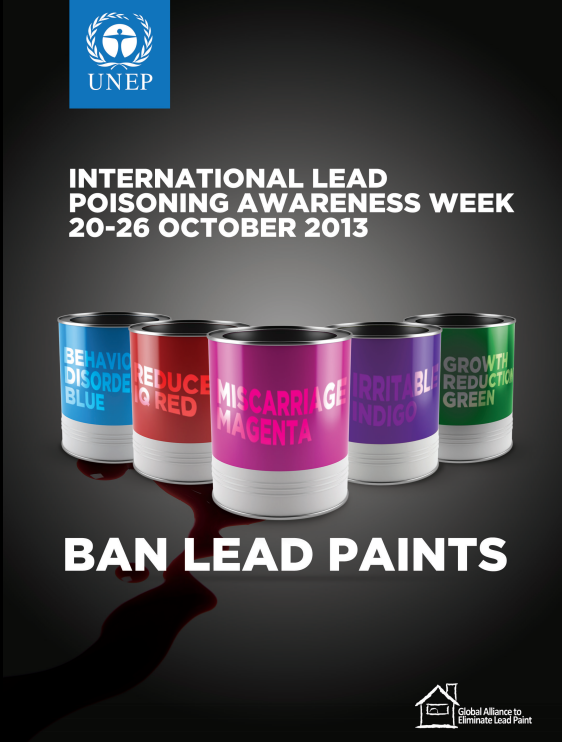
The International Week of Action on Prevention of Lead Poisoning (October 20-26th 2013) is aimed at addressing the lack of awareness of this issue.
During the campaign week, the Global Alliance to Eliminate Lead Paint aims, among others actions, to:
Raise awareness about lead poisoning:
Highlight countries and partners’ efforts to prevent childhood lead poisoning; and
Urge further action to eliminate lead paint.
The Global Alliance to Eliminate Lead Paint is a voluntary collaborative initiative to focus and catalyze the efforts of a diverse range of stakeholders to achieve international goals to prevent children’s exposure to lead from paint and to minimize occupational exposures to lead paint. The Global Alliance is a joint undertaking of the United Nations Environment Programme (UNEP) and the World Health Organization (WHO)
The Global Alliance is focusing initially on efforts to eliminate exposures to the most vulnerable populations and will focus on eight principal actions to address the gaps identified in the GAELP business plan strategy. These principal GAELP business plan actions establish the foundation for achieving the goals and objectives of the Global Alliance.
Priority actions for 2012-2013, drawn from the GAELP focal area workplans include the developing of a proposal and obtaining broad support among Governments, clinical and public health professionals and other stakeholders for the marking of an international day of action on prevention of lead poisoning with an initial focus on eliminating lead paint (relevant to focal areas on health aspects and on environmental aspects);
Lead is a toxic metal whose widespread use has caused extensive environmental contamination and health problems in many parts of the world. It is a cumulative toxicant that affects multiple body systems, including the neurologic, hematologic, gastrointestinal, cardiovascular, and renal systems. Children are particularly vulnerable to the neurotoxic effects of lead, and even relatively low levels of exposure can cause serious and in some cases irreversible neurological damage.
Despite what is known about the health risks arising from lead paint, such paints are still widely available and used in many countries for decorating the interiors and exteriors of homes. It can also be found in paint in public buildings such as schools and hospitals, as well as on toys, toy jewellery, glazes, furniture, and playground equipment.
Lead poisoning is entirely preventable, yet lead exposure is estimated to account for 0.6% of the global burden of disease, with the highest burden in developing regions. Childhood lead exposure is estimated to contribute to about 600 000 new cases of children with intellectual disabilities every year. Even though there is wide recognition of this problem and many countries have taken action, exposure to lead, particularly in childhood, remains of key concern to health care providers and public health officials worldwide.
Phasing out lead in paint
WHO has identified lead as one of ten chemicals of major public health concern, and lead requires action by Member States in order to protect the health of workers, children and women of reproductive age. Such actions include adopting regulations and procedures to eliminate the use of lead decorative paints and provide information to the public on renovation of homes where lead paint may have already been applied.
“Paints with extremely high levels of lead are still available in most of the developing countries where paint testing has been conducted as part of the efforts of the Global Alliance to Eliminate Lead Paint. In most of the countries with lead paint, equivalent paint with no added lead is also available, suggesting that alternatives to lead are readily available to manufacturers,” says David Piper, Deputy Director, UNEP DTIE Chemicals Branch. The International Lead Poisoning Prevention Week of Action, provides an excellent opportunity to raise awareness of the widespread availability of lead paint.
Worldwide, 30 countries have already phased out the use of lead paint. The Global Alliance to Eliminate Lead Paint, co-led by WHO and UNEP, has set a target of 70 countries by 2015.
At high levels of exposure, lead damages the brain and central nervous system to cause coma, convulsions and even death. Children who survive such poisoning are often left with intellectual impairment and behavioral disorders.
At lower levels of exposure, which cause no obvious symptoms and that previously were considered safe, lead is now known to produce a spectrum of injury across multiple body systems. In particular, lead affects brain development in children, resulting in reduced IQ, behavioral changes such as shortening of attention span and increased antisocial behavior, and reduced educational attainment. These effects are believed to be irreversible. Adults are at increased risk of kidney disease and raised blood pressure.
For more information and to take action click here
Source: http://www.unep.org


